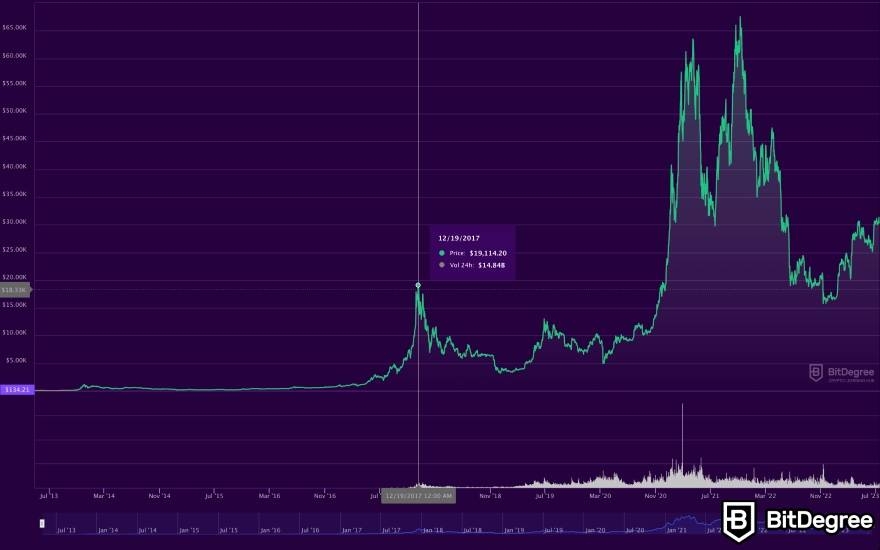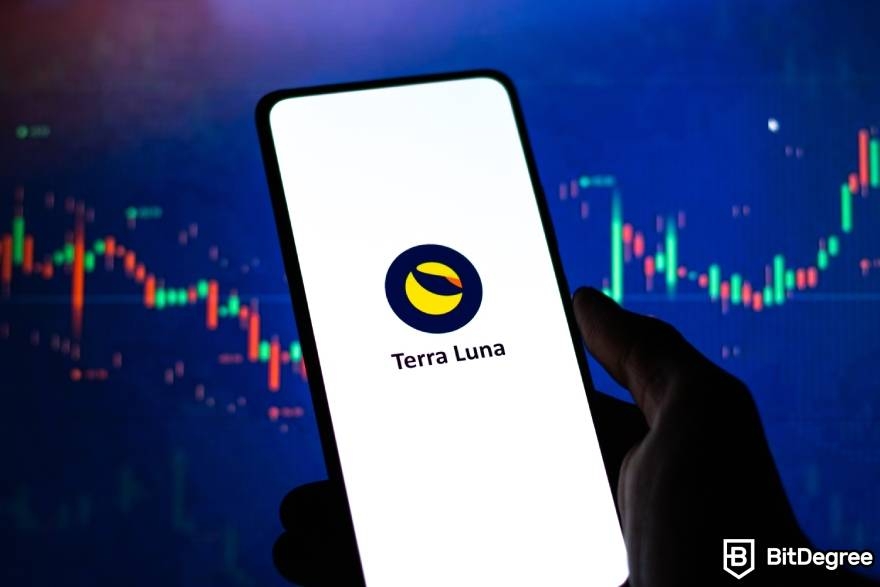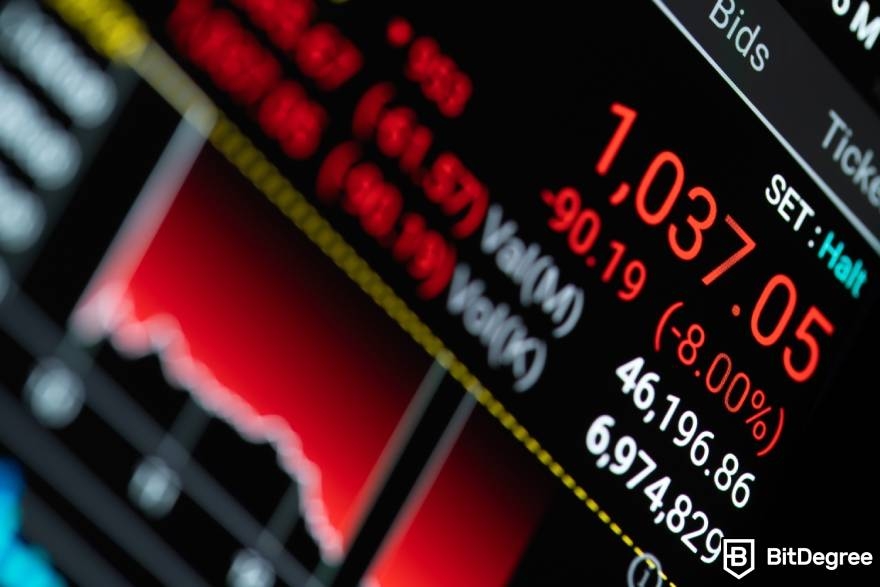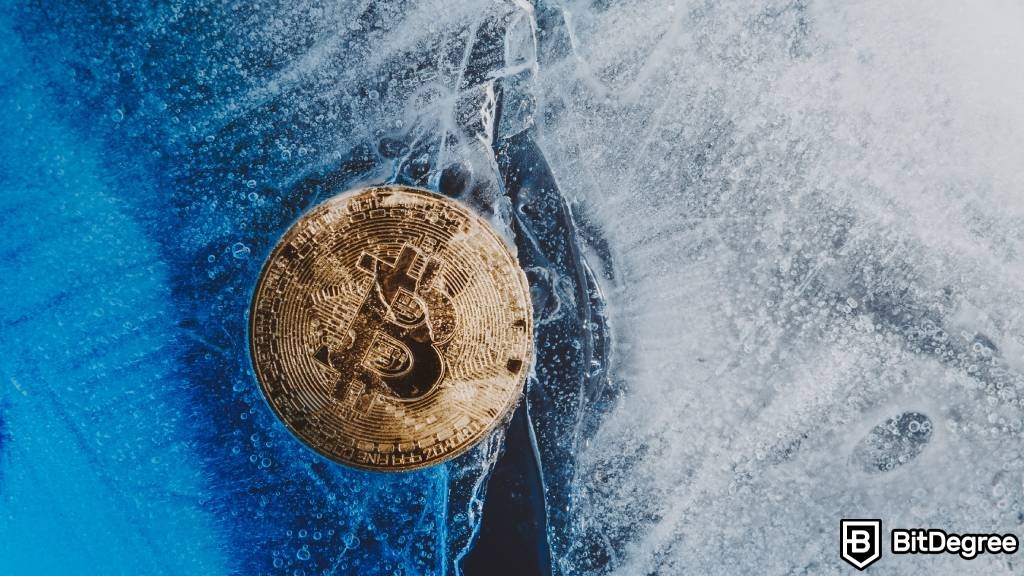Stop overpaying - start transferring money with Ogvio. Sign up, invite friends & grab Rewards now! 🎁
Are you curious about the crypto winter meaning? It would seem that everyone is talking about it in the crypto world, pondering when will this crypto winter end, how long will crypto winter last, and other, similar questions. Lately, this topic appears to be unavoidable, whether you’re trading crypto on Binance or Kraken, interacting with your Ledger hardware wallet, or simply researching the latest market trends.
Before trying to find the answers to those questions, you must first develop a good grasp of the concept, and really understand what is crypto winter. Even though the end of the latest crypto winter has been proclaimed by some, others are warning that the cryptocurrency market is still volatile and uncertain. Fear not - if you feel confused and lost, I’ve put together important bits of information to help you out.
Specifically, I'll tell you about crypto winters in greater detail, unpacking what is the meaning and significance behind this uncertainty-filled period!

Did you know?
Subscribe - We publish new crypto explainer videos every week!
What is a Bitcoin Faucet? Pros & Cons Explained (With Animations)


Table of Contents
What is Crypto Winter Meaning?
The crypto winter meaning refers to a period of time in the cryptocurrency market where there is a prolonged period of price weakness and lower overall trading volume. A period that can last for several months or even years.
Latest Deal Active Right Now:The expression likely came from the HBO series "Game of Thrones", as characters often say, "winter is coming". In the show, the expression essentially refers to a dark and turbulent time that is about to start, in the same way that a crypto winter is a perilous period for the crypto market.
During this time, the value of cryptocurrencies generally experiences a significant drop, and trading volumes also decline. Do keep in mind, though, that a crypto winter is not just about the lower prices of digital assets, but it also has several other associated aspects.

For example, due to the decline in trading volume, major cryptocurrency exchanges often reduce their staffing.
Furthermore, the market sentiment during this period is bearish, which means that prices are dropping. However, not every bear market can be called a crypto winter - that's something that you need to understand, when looking into the crypto winter meaning!
In other words, a minor dip in prices or a short-term decline in trading volume does not constitute a crypto winter. The lack of a clear metric or regulatory definition makes it challenging to pinpoint when a crypto winter has started or ended.

The bear market analogy seems fitting at first, as bears hibernate during winter, and the market movements can seem slow and sluggish during this time. However, some key points differ between a bear market and a full-on crypto winter.
A bear market is defined as a market where prices decline by at least 20% from peak values. However, in the cryptocurrency market, there is no specific metric by which a crypto winter occurs.
Furthermore, there's no regulatory authority or entity that can declare a crypto winter. Instead, it's a situation where both exchanges and investors see specific continuous patterns.
What Causes Crypto Winters?
Now that you know the crypto winter meaning, it is important to know what causes it. There are various reasons why a crypto winter can occur. It can be due to a lack of regulatory clarity, a decrease in interest from institutional investors, or simply a result of market saturation.
In some cases, a major security breach or hack can also damage investor confidence in the entire market, leading to a crypto winter.
As I've explained earlier, similar to a bear market in traditional markets, investor confidence plays a crucial role. It can affect prices (and potential decline), and the overall outlook of the space.

Consequently, negative sentiments about value, liquidity, and security concerns only aggravate the problems caused by the crypto winter. Financial losses follow, such as organizations ceasing operations or declaring bankruptcy. All of this can also contribute to a crypto winter phenomenon.
A slowdown in the development of new blockchain-based projects is also typical. Many companies in the cryptocurrency space may experience financial difficulties, leading to layoffs or even the aforementioned bankruptcy.
Obviously, a crypto winter is a situation that affects multiple cryptocurrencies and various aspects of the crypto market. Understanding the crypto winter meaning is only a part of the journey. This is because a crypto winter can have significant implications for those invested in cryptocurrencies, as it can impact their portfolio's value and overall market sentiment.

During this time, investors may feel hesitant to buy or sell cryptocurrencies due to the market's bearish sentiment, which is exactly what leads to lower trading volumes. This can exacerbate price weakness, causing the earlier-discussed vicious cycle of declining prices and trading volumes.
So, are we in a crypto winter now? Depending on when it is that you're reading this, many would agree that, yes, we still are in a crypto winter as of mid-2023. However, since not all price declines in the market qualify as a crypto winter, the severity and duration of the decline must be significant enough to warrant the term.
Still, it remains an important concept for investors to understand when considering investing in cryptocurrencies, in addition to the general crypto winter meaning. That being said, we can still spot differences if we compare what’s happening right now to the crypto winter history. That way, we can start tinkering with information to figure out when will crypto winter end.
Crypto Winter History: Then and Now
The first-ever crypto winter arguably happened in late 2013. Bitcoin increased in value at the start of the year. But by the end of 2013, its price fell a whopping 80%. Naturally, the market was shaken severely and flipped upside down.
Later, in 2017, there was a big surge in the value of Bitcoin and other cryptocurrencies, followed by a crash in 2018, only to recover a few months after. The term “crypto winter” emerged in popularity by then, as there was a necessity to name these harsher market conditions.
In the first months of 2020, the market took another remarkable hit, at first similar to a harsh bear market, but escalating quickly. It took some time to recover, and the all-time high came with 2021’s hype. Two more big crashes with spiky recoveries also took place, first in April 2021, and then in November of the same year.

Fast forward to 2022, the cryptocurrency market faced significant headwinds that resulted in the value of popular cryptocurrencies such as Bitcoin (BTC), Ethereum (ETH), Cardano (ADA), Ripple (XRP), and others dropping by more than 50%, each.
Multiple stablecoins failed, and various crypto exchanges collapsed, contributing to investor uncertainty. Meanwhile, security concerns and potential future regulations added to the downward pressure, along with broader issues such as inflation and recession in the macroeconomy.
While there are some similarities between this recent crash and the one in 2018, there are also some differences. For example, a lot of people who don't know much about crypto have lost money this time around. In the past, many of the losses were suffered by more experienced traders, who might have already figured out the crypto winter meaning.

The very reasons behind it are different this time, if compared to crypto winter history. One of the main factors is macroeconomic issues, such as inflation, that have caused the US Federal Reserve and other central banks to raise interest rates.
Another thing that's different now is that Bitcoin and other cryptocurrencies are more closely correlated with the stock market than they were before.
In fact, in the second quarter of this year, Bitcoin had its worst quarter in over a decade, and the tech-heavy Nasdaq fell over 22%. This caught a lot of people in the industry off guard, including hedge funds and lenders.
Lastly, one more big change from the last time there was a crypto winter is that there are now more big players from Wall Street involved in the crypto market. These players are taking bigger risks, using highly leveraged positions, which can cause even more volatility in the market.
Those factors are a mix of the direct effects and the indirect aftermath of what we call a crypto winter, meaning - it's a mixture of things. But what is the situation now?
Are We in a Crypto Winter?
In crypto winter history, we still have few examples to draw patterns from. As of now, the answer to the question “are we in a crypto winter?” is, by popular opinion – yes, we are. Since 2022, actually.
Many enthusiasts will tell you that the current crypto winter was triggered by the surge of U.S. inflation to multi-decade highs, prompting the Federal Reserve to aggressively raise interest rates. In response to rising rates, investors began selling risky assets such as cryptocurrencies and stocks.
Therefore, falling crypto prices exposed over-leverage among crypto lenders, exchanges, and hedge funds. After this series of unfortunate events, a domino effect of financial losses was triggered, leading to a disintegration of investor confidence in cryptocurrency.
Additionally, in May 2022, the TerraUSD and Luna stablecoin crashed, taking billions of dollars of investor equity with them. This crash led to a crisis of confidence in the overall stability of the cryptocurrency markets, dragging down the values of the market overall.
And, in the same year, in November of 2022, the bankruptcy of FTX occurred. It was a prominent crypto exchange event that led to billions of dollars in losses for investors. This event also had a significant impact on the cryptocurrency industry, as a whole.
As a result of FTX's bankruptcy, the BlockFI exchange also went bankrupt due to its exposure to FTX assets, leading to further investor losses. There's a lot of context behind the crypto winter meaning!
The widespread impact of the crypto exchange bankruptcy had caused ongoing fears about potential new regulations that could place more controls on cryptocurrency, further eroding investor confidence and extending the period of the crypto winter.

Despite the negative impact of a crypto winter, many experts see it as a necessary step in the development of the industry. During this time, many weak projects that were only created to cash in on the hype surrounding cryptocurrencies may fail, leaving only the strong projects that have real potential for growth.
In addition, the cryptocurrency market can be seen as a buyer's market during a crypto winter, as prices are low, and opportunities for long-term investments may be more favorable. If you want to find opportunities within the market, understanding the crypto winter meaning is important!
In summary, if you’re asked, you can answer that the most recent crypto winter was triggered by a combination of factors. Those include rising inflation rates, aggressive interest rate hikes, and a series of unfortunate events such as the TerraUSD and Luna crash.

However, many might say that the underlying issues that contributed to the decline in investor confidence had been brewing for some time.
Those factors, only known to the ones interested enough to research in-depth, include a lack of regulatory clarity, and concerns about liquidity and security. There was also alleged over-leverage among crypto lenders and exchanges, which may have contributed to a market saturation on the crypto scene.
So, now you understand better what causes a crypto winter, as well as notions around crypto winter meaning. Naturally, your next questions likely sound a little something like this: is crypto winter over? If not, then when will this crypto winter end?

- Secure and reliable
- Accepts fiat currencies
- Lots of trading options
- Reputable exchange
- Accepts fiat currencies
- Offers various trading options

- Huge trading variety
- Regulation-compliant around the globe
- Fair trading fees
- Beginner-friendly
- A wide array of features
- Vast number of different crypto coins & tokens

- Beginner-friendly
- Secure
- Decent trading and withdrawal fees
- Crypto.com Visa Card
- Automated tools & bots
- Ecosystem synergy with CRO
How Long Does a Crypto Winter Last?
As you saw in the "Crypto Winter History" chapter, the first significant crypto winter took place in January 2018 (even though there was one in 2013, the 2018 crypto crash is what most people view as the first "real" crypto winter, meaning, when a huge amount of people started calling the phenomenon just that).
The cryptocurrency market experienced a significant decline, which lasted for almost 2 years. This raises a lot of questions, like “what is the expected length of a crypto winter?”, “when will crypto winter end?”, and even “are we in crypto winter, still?”.
To answer everything, it’s important to keep in mind that, as with any market, the cryptocurrency market history is subject to cycles of growth and decline. This means that a crypto winter, which is a period of decline in the cryptocurrency market, is not a permanent state.

So, if we analyze the crypto winter history, we can conclude that historically, the market had undoubtedly bounced back from such negative events. With this in mind, many experts believe that it will do so again in the future.
Hence, It's important to note that there is no precise metric for determining when a crypto winter begins or when it ends. Instead, a general market consensus is the only way to measure the value of cryptocurrency on its rise and / or fall.
The exact timing of the crypto winter of 2022 is somewhat up for debate, starting in earnest around the time of the collapse of TerraUSD and Luna, and continuing into 2023. According to some analysts, the downturn was not abrupt, and its wheels were set in motion earlier in 2022.
For that reason, numerous technical analysis (TA) models exist that attempt to answer the question of how long a crypto winter will last. These models look at historical trends within the crypto industry to try and extrapolate a cohesive narrative based on that data.

Consequently, several TA models indicate that the cryptocurrency market may be on the verge of a turnaround, and we may begin to see the initial indications of the market warming up, which could give us a hint about when will crypto winter end.
However, the main con of this view is that it is retroactive, as it uses previous data to make models and does not account for new or upcoming events. On top of that, those models don’t take into consideration the differences between the data we have about crypto winter history and what’s exactly happening now.
Another prominent theory about the current situation has to do with the next Bitcoin halving, since it is common knowledge that Bitcoin is the tide that raises all ships in crypto. While we are starting to see some projects operate independently of Bitcoin's price fluctuation, the overall trend remains that when Bitcoin's price moves in one direction, so does the rest of the market.

This theory could be used as a measuring stick for predicting when will this crypto winter end, or how long it will last.
However, the lack of widespread adoption of cryptocurrencies and limited broker acceptance leaves the market vulnerable to external influences. Which influences, you ask? Well, there are many, such as rising inflation and interest rates, all of which contribute to creating a challenging environment for investors.
Thus, with capital no longer cheaply available, we are seeing a slowing down in the economy. Institutional investors can’t borrow as readily, so they can’t invest in crypto projects or hold as many high-risk assets, such as crypto.

As an attempt to combat high inflation, central banks started and continue to raise prime interest rates, marking the end of cheap capital as borrowing became more expensive.
In summary, while there is no clear answer to how long a crypto winter will last, the market has always bounced back from these periods of decline in the past. Numerous technical analysis models and the Bitcoin halving cycle are two prominent theories that might predict the end of crypto winter.
Nevertheless, without mass adoption and limited acceptance by merchants, we will remain beholden to forces outside of our control. High inflation and rising interest rates may keep occurring, which could prolong the crypto winter.

However, as the industry has matured and becomes more mainstream, there are now more sophisticated investors and companies with greater resources. This can help to weather the storm known as the crypto winter.
Additionally, while the market may experience periodic downturns, the overall trend of the industry has been upward. Cryptocurrencies and blockchain technology appear to continue gaining wider acceptance and adoption.
As such, while a crypto winter can be a challenging time for the industry, it is not necessarily a sign of the end of the cryptocurrency market.
Tips on Surviving a Crypto Winter
Just knowing the crypto winter meaning may not be enough information to really deal with it. Some traders may even feel sick to their stomachs when crypto prices fall, so I've prepared a few tips that can help you survive a crypto winter. Note that none of them are financial advice - just some tips that I myself have found helpful, in different scenarios. Always consult with a qualified financial advisor before making any investment moves!
Firstly, you don't have to hold onto crypto that's down if you don't think it's coming back. It's okay to sell and make portfolio adjustments whenever you deem it necessary.
Next, if you believe a cryptocurrency downturn is temporary, you may want to buy in at lower prices, hoping to buy low and see the value of your portfolio grow while the markets recover. Remember that it's best to keep your investments in assets you understand.

Now, since no one knows exactly how long will this crypto winter last, there are several trading strategies for surviving a crypto winter.
Short selling can be beneficial when the price of equity declines in value. This is a strategy where an investor borrows a cryptocurrency, usually from a broker or exchange, and sells it in the market, expecting a decrease in prices. The goal is to buy back at a lower price, thus making a profit.
DCA is also a common strategy for volatile equity markets where investors continue buying security even during a period of decline to lower the average purchase cost.

Avoid intraday trading and leveraged trading during choppy market conditions. Remember that bear markets are common in traditional equity markets, and eventually, those markets recover.
Keep an eye on market trends! It's always important to stay up to date on the latest news and trends in the crypto market. By monitoring market sentiment and developments, you can make more informed investment decisions.
In all trading strategies, managing risk is crucial, and investors should not risk more than they can afford to lose. You should also evaluate each crypto project carefully because some have proven to be scams. Avoid the herd mentality and focus on your personal goals and risk tolerance.

Not only are the market strategies important, but the mindset needs to be strong as well. Additionally, it's important to remain patient and not get too caught up in short-term market movements.
Keeping a long-term perspective can help you stay focused and avoid getting distracted by short-term noise. Being immediatist and repeatedly asking yourself “is crypto winter over yet?” may bring frustration.
You could also take profits, when you think it's a good idea to do so. During a crypto winter, holding on to your investments in hopes of future gains can be tempting. However, it's optional to take profits when the opportunity arises. This can help you mitigate risk and secure gains before market conditions worsen.
You should also have a plan for your crypto holdings. This includes setting clear goals, such as a target price to sell at, or a percentage of your portfolio to reallocate.

By having a plan in place, you can avoid making impulsive decisions based on emotions or short-term market movements. It's also important to regularly review and adjust your plan, as market conditions change.
You might also want to break up with your portfolio tracking app for a while. This is done to avoid getting constant reminders of how much you're down from your portfolio's all-time high.
Diversity is key. Some specialists say it's wise to spread your crypto investments across different projects and cryptocurrencies to reduce risk. This way, if one investment performs poorly, you won't lose all your money.
Overall, surviving a crypto winter requires patience and a long-term outlook. It's important to don’t forget the crypto winter meaning, limitations, and causes, and remember that crypto markets are still in their infancy.
There will be ups and downs along the way. By staying focused on your goals and holding on to your investments, you can weather any market storm and be proud when crypto winter is over.
Conclusions
In conclusion, the crypto winter means a challenging period for the cryptocurrency market, but it is not the end of the road. As with any market, there will be ups and downs, and investors need to remain patient and stay informed.
As the market continues to mature, we can expect to see new regulations and technologies emerge that will help to stabilize the market and increase investor confidence. In the meantime, it is important for traders to remain cautious and apply safer strategies.
As of now, the crypto market future continues to be uncertain, as it always was. Nonetheless, it is expected to recover, sooner or later. As more institutional investors and traditional financial institutions get involved in the space, there are more optimistic views around when will crypto winter end.
As a side note, be sure to keep your funds safe, whether it’s a crypto winter or not. To do that, I suggest getting a hardware wallet, which will surely help you sleep more soundly at night. Some of the best hardware wallets on the market include the Ledger Nano X or SafePal.
The content published on this website is not aimed to give any kind of financial, investment, trading, or any other form of advice. BitDegree.org does not endorse or suggest you to buy, sell or hold any kind of cryptocurrency. Before making financial investment decisions, do consult your financial advisor.









